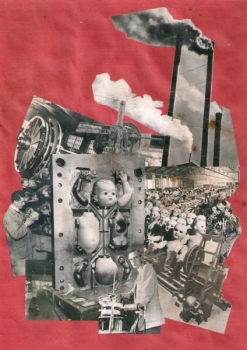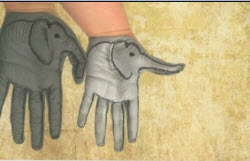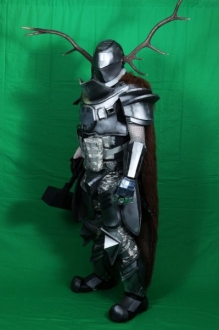By Suzanne Kelly.
Each year Gray’s School of Art holds an end-of-year degree show; this has become a highly-anticipated social as well as artistic fixture in Aberdeen’s cultural calendar.
Jewellery, photography, fashion, painting, design, sculpture and ceramic work by graduating students is displayed then scrutinised, and while the atmosphere is enjoyable, it is still a serious business for fledgling artists.
This year’s overall creative quality was considered outstanding by students, faculty and visitors alike.
Societal issues seemed to dominate the graduates’ work, with design students in particular addressing the issues of our time and the future.
In many ways it is reassuring to know that such thoughtfulness, creativity and effort is being brought to bear on the world’s problems, ranging from the cities of the future to the needs of children.
Issues of mental health, hunger, poverty, freedom, violence and freedom were given artistic attention with some very creative observations and solutions advanced. A striking work on depression used distorted and burnt images of men and women displayed on a grid. A work concerning Aberdeen asked viewers
Steven Bremner’s work examined how the problems of today may well manifest in a future dystopia:-
“Our outlook on the future is somewhat skewed by the culture and imagery that we surround ourselves with. Images of violence and corruption shown on news media leave a sour taste in our mouths. Television and cinema give us visions of the future that are negative. Newer cultural outputs such as gaming and the internet are used exploitatively by their owners to seize our data without our permission or knowledge.
“All of these aspects of every day culture distort our view of the world and by extension, our view of future. That through societies actions or inaction, a Dystopian future is being created, a Dystopia being an undesirable future, the opposite of Utopia.”
His strong collages echoed a potential future metropolitan world – crowded, gray, problematic, cold. A video was part of his work, which can be viewed here http://www.youtube.com/watch?v=J51FE6pMoDA
Susannah Leake’s sensitive work was geared towards helping children deal with the problems of senility and illness in a grandparent via a child’s book.
‘Even Elephants Sometimes Forget’ is tender, thoughtful work (the imagery is of human hands painted to look like elephants); there was a blackboard on which a simple phrase was written. Viewers were invited to memorise the phrase, erase it, and write it again from memory.
This simple exercise reminded those who participated what an ephemeral yet critical, personal faculty memory is.
The problems of the increasing ageing community and issues such as senility, and how children can be helped to cope with this problem in a grandparent will require consideration and solutions such as Leake proposes.
The range of work was itself impressive. Lorna Glencross worked on the theme of ‘Death, Love, and all of the Above;’ she commented on her work:-
“My work this year has been focused in iconography and its power in ownership, religion and spirituality. Death, Love and all of the above is a modern day shrine that has no specific religion or origin but gives the viewer a sense of calm and time to reflect…. My aim was to create something that was visually pleasing but asked questions about the fundamental issues we face in the future. Our relationship with science and our morals, aims and desires.”
Graduating student Ruaraidh Cable addressed the increasing use of computer generated images (CGI) which is reflective of the growing overlap and integration of the digital and the biological. He commented:-
“I decided to look into the relationship between the digital and physical world. I noticed recently that in several major film releases there has been a trend to replace roles traditionally played by human actors with CGI creations.
“In many cases I felt that this fails to work effectively as the CGI characters lack the visceral impact that a human performer brings. The conclusion to this topic was two full sized wearable suits, one of which was from already existing content while the other was a character of my own creation.
“Both suits were created using a digital file as the starting point. The overall goal of this project was to show that digital and physical can complement each other rather than one obviating the other.”
There was a great deal of commendable work, and it is unfortunate that there isn’t enough space for commenting in detail or including images for all of these. However, notable work from artists including John Nicholson, Zack Anderson, painter Jamie Steele, Ashley Morris, Rachel Furness, Holly Aitchison, Michael Loudon, and Stacey Geddes all memorably resonated and impressed.
There might not be space for their work in this brief article, but it seems certain you will be seeing their work in the future, as well as their peers.
Unfortunately the fashion students’ work was either in the VIP tent and inaccessible to those without tickets, or unceremoniously hung on the wall unceremoniously in a large untended room in the main building.
From the dozens of distinctive garments I was drawn to an ethereal and classic salmon-coloured chiffon, pleated and embellished with pearl-coloured beads. Unfortunately, hardly any of the fashion work was clearly labelled, so crediting these designers is problematic.
Good design can help us deal with the problems the future will present; the clues to the future’s issues are in the present. Fine art, crafts and wearables reflect our society, draw from the past and anticipate the future.
Our upcoming photographers will record our successes and defeats. In a world where higher education is coming to mean vocational training with a focus on future earnings, the arts have never been more important.
Grays has this year successfully nurtured our future artists and creators, whose skills we need now to help shape a better future.
- Comments enabled – see comments box below. Note, all comments will be moderated.


